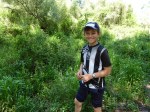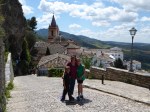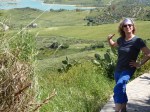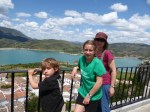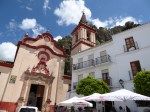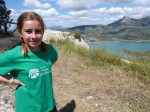A few parents at Colegio Gómez Moreno had arranged a weekend outing in May: on a Friday, families would meet at a guest house on the outskirts of the pueblo blanco Prado del Rey [in English, the King’s Meadow] about 220 kilometers west of Granada. The next day, we would rent bicycles in Olvera, then ride 38 kilometers along the Vía Verde de la Sierra over viaducts, past meadows, and through tunnels, arriving in Puerto Serrano before the bar closed. Happily, we signed up for the trip. We headed out a day early, by way of rental car, along highway A-92 with a short detour to the town of Ronda.
Say the name Ronda and what pops into your head? An overplayed song by the Beach Boys dating back to 1965? A fixed form of lyrical French verse based on two rhyme sounds, fourteen lines and three stanzas? Or a pueblo blanco in Málaga province famous for la Plaza de Toros and the enormous gorge, El Tajo?
For us, Ronda means narrow, winding, medieval streets; an enormous, American-sized SUV — a rolling behemoth which terrorized us every time we had to park, turn, or back up (Thank you, Jose Luís at Hertz Granada for the “upgrade” from the efficient, compact Toyota Auris which we had reserved 4 weeks prior!); and multiple chances to fall 390 feet into the Río Guadalevín.
- Narrow Ronda street with innocent pedestrian.
- Narrow Ronda street with vehicle (not ours) and tourist.
- Where you end up if you make the wrong turn.
Sometime in the 4th century, Saint Ambrose was said to have declared: “When in Rome, do as the Romans do.” In truth, he proclaimed: “When I am here [in Milan], I do not fast on Saturday; when I am in Rome I do fast on Saturday.” Had he stated, “When I am here [in Pasadena] I do not walk back and forth across Puente Nuevo; when I am in Ronda I do visit Casa Don Bosco, and I attend the Ronda Guitar House, located at Calle Pedro Mariano Soubiron, and therefore I do hear Paco Seco play classical and flamenco guitar” then perhaps we would not have had to rely so heavily on our Lonely Planet guidebook.
After descending and ascending the gorge, crossing the bridges Puente Arabe and Puerto Viejo and sorting through the many bull-themed items at the gift shop of the Plaza del Toro, we stumbled upon a fascinating map of El Cerdo which answered some questions that had been plaguing us as we navigated the restaurants of Andalucía.
BONUS TRAVEL BLOG QUIZ: Indicate the country of origin of each of the passersby that D. roped into taking our picture during our 24 hour stay in Ronda.
- D., A., M., J.
- M., J., A., D.
- A., J., M., D.
After leaving Ronda, we continued to Cádiz province and joined our friends outside of Prado del Rey at Cortijo Huerta Dorotea, a rural farmhouse featuring a lodge and casitas overlooking the Sierra de Grazalema. The next morning, we caravanned to Olvera where we began our cycling adventure across thirty-eight kilometers, through twenty-four tunnels, completing one lunch break, and quaffing zero to three beers, depending on endurance, body weight and legal age for alcohol consumption. (For historical side note about the Olvera-Puerto Serrano Vía Verde, please scroll down.)
A short walk the next day along the Sendero Rio Majaceite followed by a lazy stop at the hillside town of Zahara de la Sierra, and our trip to a beautiful region in Cádiz province was complete.
- A stork in a nest on a pylon.
- Ex-pat Aussie, posing nicely.
- Ex-pat American on the sendero.
- Famous history professor researching the surroundings.
- A steep street in Zahara.
- On the way to the Arab fortress.
- Overlooking an engineered lake.
- Zahara town square.
- Cutie.
There are dozens of Vías Verdes throughout Spain. They are former light rail lines, now converted to biking and hiking trails. For a condensed version of our entire Vía Verde de la Sierra experience, please check out this YouTube link created by our friend J.v.H.:
Historical Side Note: West of Algodonales on the Ronda-Seville road between Puerto Serrano and Olvera lies a light rail line, now converted into the vía verde so described in this blog post. The military regime led by General Rivera, between 1923 and 1929, decided to build a light railway to carry agricultural products from Almargen to Jerez de la Frontera (General Rivera’s home town). Thirty-eight kilometers of the 123 kilometer route were completed before the project went bust. (Please submit any emendations, corrections, or addenda to the Response tag at the close of this post.)

























































